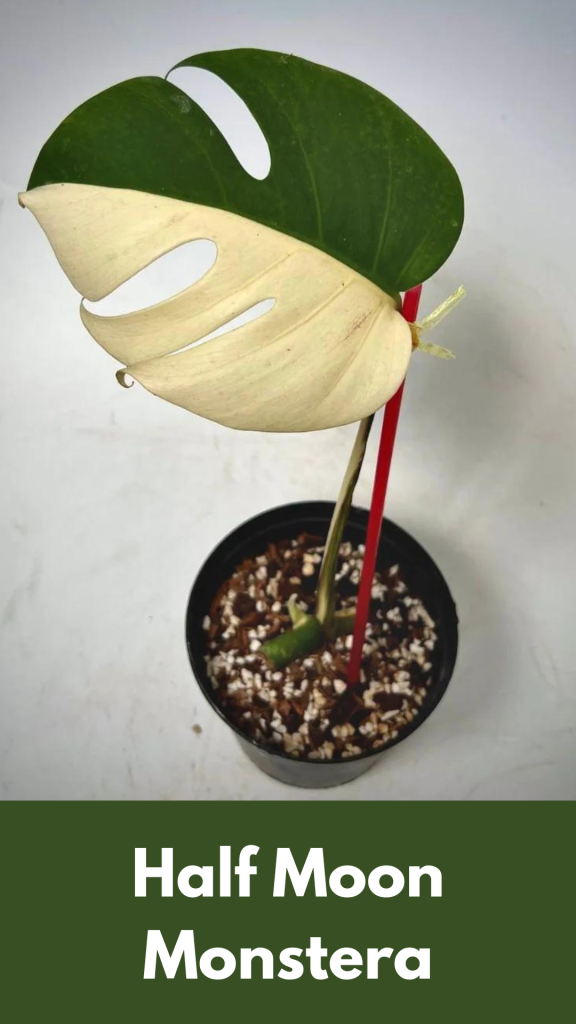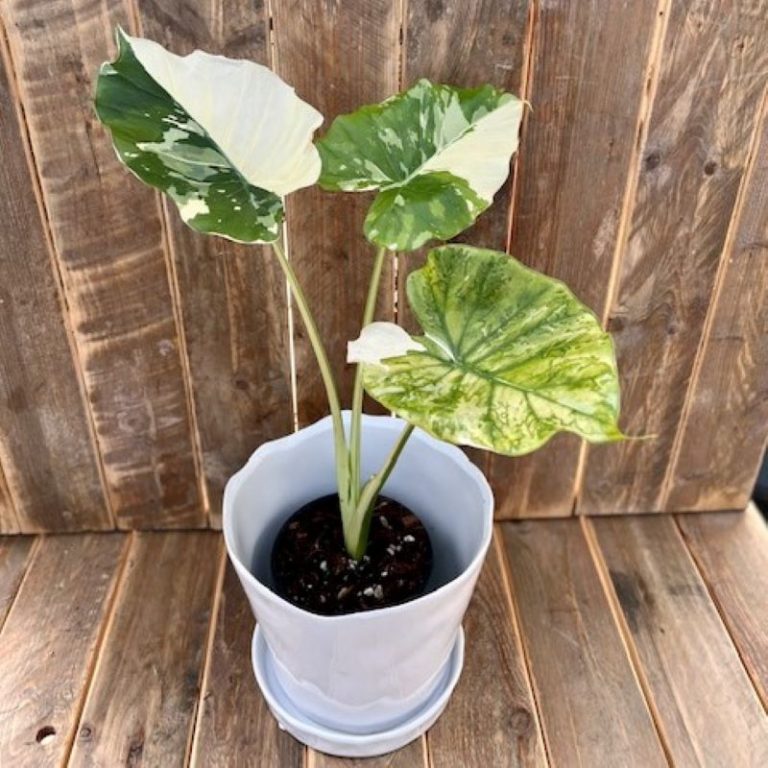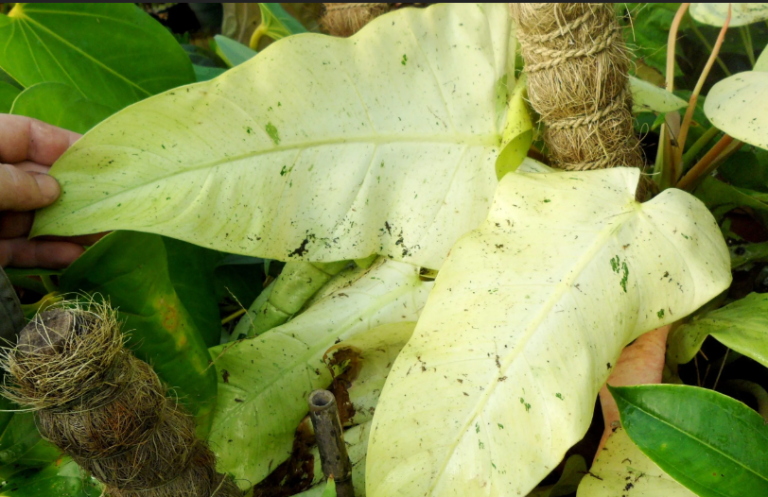Half Moon Monstera, also known as Monstera adansonii ‘Half Moon,’ is a popular houseplant among plant enthusiasts for its unique foliage. This plant is a variation of the more commonly known Swiss Cheese Plant (Monstera deliciosa), but it has smaller leaves with distinctive white variegation that gives it its half-moon appearance.

The Half Moon Monstera is native to the rainforests of Central and South America and is an easy-to-care-for plant that can thrive in a variety of indoor environments. Its striking appearance makes it a popular choice for adding visual interest to any space, and its hardy nature makes it an ideal plant for beginners and experienced gardeners alike.
Whether you’re looking to start your indoor plant collection or add a new member to your existing one, the Half Moon Monstera is definitely worth considering.
Botanical Classification of Half Moon Monstera
| Kingdom | Plantae |
| Clade | Tracheophytes |
| Clade | Angiosperms |
| Clade | Monocots |
| Order | Alismatales |
| Family | Araceae |
| Genus | Monstera |
| Species | Monstera adansonii |
| Variety | ‘Half Moon’ |
Benefits of Half Moon Monstera
The benefits of Half Moon Monstera go beyond its unique and attractive appearance. Here are some of the benefits of having this plant in your home:
- Air Purification: Like many other houseplants, Half Moon Monstera is an effective air purifier, removing harmful toxins from the air and promoting cleaner, fresher air quality in your home.
- Aesthetic Appeal: With its unique, eye-catching foliage, the Half Moon Monstera is an excellent way to add visual interest to any space. Its variegated leaves can brighten up a room and add a touch of nature to your home decor.
- Low Maintenance: Half Moon Monstera is an easy-to-care-for plant that requires minimal attention. It can tolerate low light and infrequent watering, making it an ideal choice for those who don’t have a lot of time to devote to plant care.
- Stress Relief: Research has shown that having indoor plants can help reduce stress levels and improve overall mood. The Half Moon Monstera’s soothing greenery can have a calming effect on your mind and help you feel more relaxed.
- Boost Productivity: Indoor plants have been shown to boost productivity and creativity in work environments. The Half Moon Monstera’s attractive appearance can provide a positive and refreshing ambiance to help you focus and stay motivated.
How to care for Half Moon Monstera
| Light | Half Moon Monstera thrives in bright, indirect light. It can also tolerate low light conditions, but growth may be slower and variegation may fade. Avoid direct sunlight, which can scorch the leaves. |
| Water | Half Moon Monstera prefers to be kept evenly moist, but not waterlogged. Allow the top inch of soil to dry out before watering. Overwatering can lead to root rot, while underwatering can cause the leaves to yellow and brown. |
| Humidity | Half Moon Monstera prefers higher humidity levels, but can tolerate lower levels as well. Use a humidifier or place a tray of water near the plant to increase humidity. |
| Temperature | Half Moon Monstera prefers temperatures between 65-85°F (18-29°C), and can tolerate temperatures as low as 55°F (13°C). Avoid placing the plant in drafty areas or near heating/cooling vents. |
| Soil | Half Moon Monstera prefers well-draining soil that is rich in organic matter. A mix of peat moss, perlite, and potting soil is recommended. |
| Fertilizer | Half Moon Monstera benefits from regular fertilization during the growing season (spring/summer). Use a balanced, water-soluble fertilizer every 2-3 weeks. |
| Pruning | Half Moon Monstera can benefit from occasional pruning to control its size and shape. Prune back any yellowing or damaged leaves, as well as any vines that have grown too long. |
| Propagation | Half Moon Monstera can be propagated through stem cuttings placed in water or soil. Allow the cuttings to root before transplanting into their own pot. |
Propagation Guide for Half Moon Monstera
Here’s a propagation guide for Half Moon Monstera:
- Prepare a stem cutting: Take a stem cutting from a healthy Half Moon Monstera plant, making sure it has at least one node (where a leaf or aerial root meets the stem). Cut the stem just below the node with a clean, sharp pair of scissors or pruning shears.
- Place the cutting in water: Fill a glass or jar with room-temperature water and place the stem cutting in it, making sure the node is submerged. Change the water every few days to prevent bacteria growth and promote healthy root development.
- Wait for roots to form: It may take a few weeks for roots to form, so be patient. Keep the cutting in a bright, indirect location and make sure the water level covers the node. Once the roots are a few inches long, the cutting is ready to be transplanted into soil.
- Transplant the cutting: Prepare a pot with well-draining soil (a mix of peat moss, perlite, and potting soil is recommended). Gently remove the cutting from the water and carefully plant it in the soil, making sure the node is covered. Water the soil lightly and place the pot in a bright, indirect location.
- Care for the new plant: After transplanting, make sure to keep the soil evenly moist and provide the plant with bright, indirect light. Avoid direct sunlight, which can scorch the leaves. As the plant grows, you may need to provide support with a stake or trellis.
Commonly Asked Questions About Half Moon Monstera
Can Half Moon Monstera grow in low light?
While Half Moon Monstera prefers bright, indirect light, it can tolerate lower light conditions. However, the plant may not grow as quickly or produce as many leaves in low light.
How often should I water my Half Moon Monstera?
Watering frequency depends on the environment and the size of the pot, but as a general rule, Half Moon Monstera prefers soil that is consistently moist but not waterlogged. Water the plant when the top inch of soil feels dry to the touch, and make sure to allow excess water to drain away.
Can I propagate Half Moon Monstera from a leaf cutting?
No, Half Moon Monstera cannot be propagated from a leaf cutting. Instead, stem cuttings with at least one node are needed for successful propagation.
How can I increase humidity for my Half Moon Monstera?
Half Moon Monstera thrives in humid environments, but it can be challenging to maintain high humidity levels indoors. To increase humidity, you can mist the plant with water, place a humidifier nearby, or group several plants together.
Why are the leaves of my Half Moon Monstera turning yellow?
Yellowing leaves on a Half Moon Monstera can be a sign of overwatering, underwatering, or exposure to direct sunlight. Make sure to adjust your watering and lighting practices accordingly to help prevent yellowing leaves.


